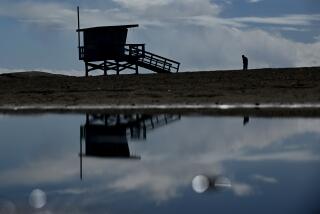Sewage Spills, Rain Close 100 Miles of Beach : Environment: Areas from Ventura County to the Mexican border are posted with health warnings. Unsafe bacteria levels may last for seven days, officials say.
An untimely and unlucky combination of tropical storms and faulty piping led to Southern California’s biggest beach quarantine in recent memory, with nearly 100 miles of coastline placed off limits by health authorities due to sewage spills.
Officials said Wednesday that the beaches would remain closed at least until the weekend, and if the rain persists the quarantine could remain in effect indefinitely.
The affected coast is in Los Angeles County, where all 76 miles of oceanfront were quarantined Monday due to a rain-triggered sewage spill, and the southernmost 20 miles of beach in San Diego County where a severed outfall pipe has spewed sewage into the surf for more than a week.
“This is one of the worst pollution situations we’ve seen in a long, long time,” said Lisa Weil, policy director of the American Oceans Campaign. “These spills should serve as a wake-up alarm to us that our system . . . needs attention.”
Beaches in Orange County, Ventura County and Santa Barbara County were not covered by the closure orders.
Test results from water samples collected off Los Angeles County beaches were not yet available Tuesday, but health officials said that levels of disease-causing bacteria undoubtedly had soared to thousands of times the safe limit.
As a precaution, they urged surfers, swimmers and waders to stay out of the water on all beaches in Los Angeles County. Health officials said the quarantine would only be lifted when tests show bacterial levels have dropped to normal.
“The soonest we would open the beaches would be in four days, and I would estimate it would be more like seven days,” said Richard Kevadjian, a division chief for the Los Angeles County Department of Health Services. “This is a very large volume of sewage . . . We’ve never had a discharge this large.”
In San Diego County, the waters are likely to be off limits much longer. A broken pipeline has been spewing 180 million gallons of partially treated sewage into the sea each day since Feb. 2, and work crews--hampered by storm-tossed seas--estimate that $10 million worth of needed repairs will not be complete until April 4.
Although bacteria readings had declined somewhat Tuesday, 20 miles of coastline from Imperial Beach north to the San Diego River remained under indefinite quarantine.
In Los Angeles County, officials blamed an unfortunate confluence of events for the record-level spill that fouled the coastal waters.
The problem apparently began at the Donald C. Tillman Water Reclamation Plant inside the Sepulveda Dam Basin, where flooding Monday caused an electrical short that shut down pumps.
Workers turned to their backup system--rerouting millions of gallons of raw sewage through a 70-year-old line to the Hyperion Treatment Plant near El Segundo. But that line was already full--its contents swollen by rainwater that typically leaks into the sewage system during heavy storms.
Officials then invoked a second relief system--diverting sewage from the overloaded pipe into a series of holding tanks beside Ballona Creek in Culver City. But the volume of sewage and rain runoff was too great, and workers Monday were forced to release more than 23 million gallons of diluted sewage directly into Ballona Creek, which empties into the ocean at Marina del Rey.
As the rains persisted Tuesday, the releases continued and the total spill reached 32 million gallons.
“The sewage they are releasing is chlorinated and screened to get the large particles out, but we consider it raw sewage,” said Kevadjian.
The spill was the largest into Ballona Creek since the holding basins were constructed by Los Angeles in 1986, Kevadjian said. The largest previous spill, he said, was about 7.5 million gallons--or less than one-fourth the size of this one.
Improvements now under way--namely, a new $120-million pipeline--should prevent similiar spills in the future, officials said. But environmentalists lamented the slow progress on the pipeline and challenged the city’s practice of chlorinating the sewage as it spills into Ballona Creek.
Mark Gold, staff scientist for Heal the Bay, argued that the chlorine treatment probably is not enough to kill disease-causing organisms but does harm marine life.
On Tuesday, the Los Angeles County Board of Supervisors approved a policy requiring officials to immediately warn the public of hazards after sewage spills, heavy rains and environmental accidents. In the past, health officials had wide discretion in closing beaches, and environmentalists complained they were slow in issuing warnings about potential dangers.
At the quarantined beaches Tuesday, bright yellow signs warned bathers of the contaminated waters and lifeguards added emphasis with messages broadcast over their public address systems. Still, all the advice in the world didn’t keep “the dyed-in-the-wool boogie boarders, surfers and ‘polar bears’ out,” according to Don Rohrer, the county’s chief lifeguard.
“We do what we can, but if the surf’s good, they don’t pay any attention,” Rohrer said as he watched several teen-agers catch waves in Venice. “They don’t seem to care much about pollution. They seem to know what their bodies can or cannot take.”
Asked whether he’d venture into the polluted surf, Rohrer said: “To save a life I would, but aside from that, nope.”
Times staff writers Mark Platte and James Rainey contributed to this story.
Coastline Closure
Reacting to sewage spills, authorities closed more than 90 miles of shoreline--the longest stretch of beach declared off limits because of pollution in recent memory.
In Los Angeles County: All 76 miles of beaches were quarantined after more than 23 million gallons of barely treated sewage overflowed into Ballona Creek.
In San Diego County: 20 miles of shoreline remain closed because of a broken sewer pipe.
More to Read
Sign up for Essential California
The most important California stories and recommendations in your inbox every morning.
You may occasionally receive promotional content from the Los Angeles Times.








